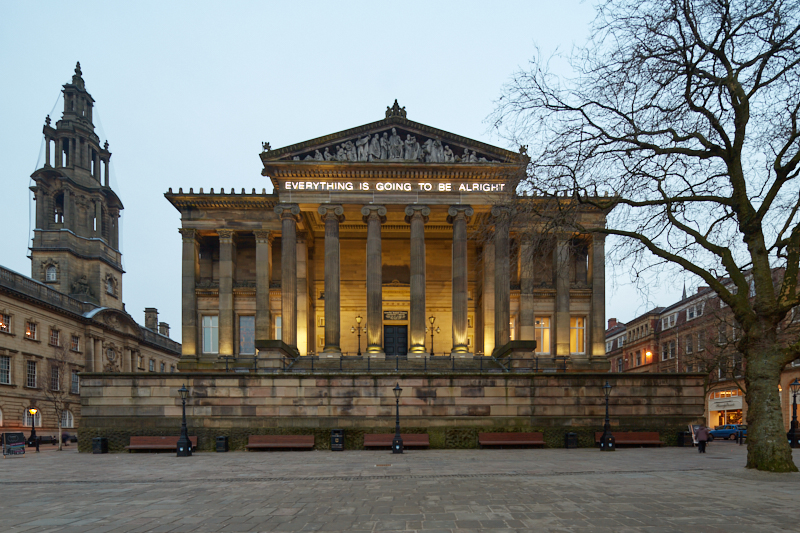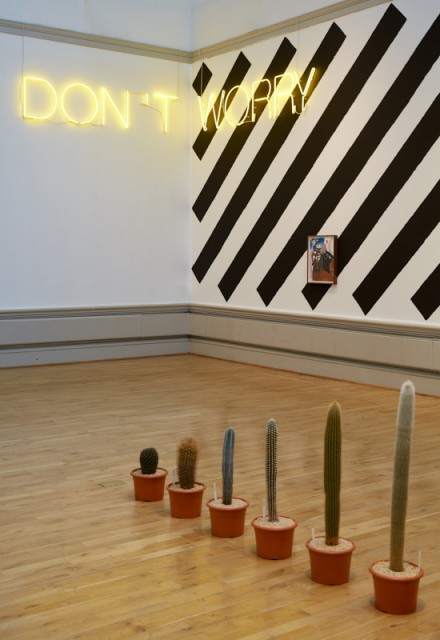“Life’s hard and I usually feel bad…” ARTIST ROOMS: Martin Creed — Reviewed

Is everything going to be alright? No, probably not. Kyle Nathan Brown ponders the anxiety and concerted naivety of one of Britain’s most popular, contemporary artists…
You’ll find ARTIST ROOMS: Martin Creed in Preston town centre; by way of Friargate, past the flag market, and announcing itself from the top of the Harris Museum and Art Gallery. “EVERYTHING IS GOING TO BE ALRIGHT”, says Creed, by way of a neon first made for Tate Britain in 1999 (also known as Work No. 203). So far, so ironic.
To explain, the ARTIST ROOMS programme is a touring collection of 1,600 modern and contemporary artworks, owned by the National Galleries of Scotland and Tate, which is shared with museums and galleries – and therefore the general public — around the UK. Creed is the latest to take part; a British artist born in 1968 and described by ARTIST ROOMS as having a “magpie enthusiasm for the beautiful and strange”.
Once inside the Harris, one of the first things to notice is the curation of Creed’s show: a straightforward, conservative use of the Victorian gallery space. Creed’s work didn’t really seem to gel, which unfortunately diminished some sense of fun that is usually present in his work. Assigned in order – a common trope in Creed’s practice – and arranged shortest to tallest were 13 cacti plant pots (Work No. 960 (2008). This very simple arrangement is arguably telling of a current artistic approach. Without the pre-established rules of Modernism, how does an artist decide themes or subjects and maintain an expressive minimal approach, such as Creed’s? His use of colour and structure are generally symptomatic of the materials he has chosen; allowing him the space to make something without having to worry about colour theory or the fundamentals of representative and abstract art.
Creed’s self-imposed rules continue in Work No. 944 (2008): 21 drawings on A4 paper, each using a different colour felt tip pen. Here, Creed has taken most of the decision making away from himself. What should I draw? Why, just fill in the paper. How many should there be? Well, there are 21 felt tip pens in the packet, so 21. What colours should I use? All of them, separately. The only real decision is whether or not to actually make the work. Nonetheless, it has a charming sense of humour behind it — a middle finger to the art world. But more than anything, Work No. 944 is a playful exploration of any perceived boundaries that art world may try to enforce.
ARTIST ROOMS: Martin Creed and his kind of naïve visual art seems to inspire a commonly heard phrase in galleries across the country: “Is this art?” Or, “I could have made that.” But rather than declaring any academic counter-argument, Creed does something different. He doesn’t call his work art at all, and seems uncomfortable by the idea of doing so. Instead, his works are named as such; Work No. __. This makes a lot more sense when the viewer thinks that Creed himself is asking the same questions about contemporary art as those who challenge it’s validity; only he is in the fortunate position to ask these questions from inside the art establishment.

Hence, we come to the controversial work in the exhibition: the lights going on and off (Work No. 227 (2000)). But what we really should talk about is Work No. 837 (2007): better known as videos of vomiting. People entering a gallery, and being sick onto the floor, one after the other; displayed on four monitors stacked two-up, two-across. What makes this work so uncomfortable to watch isn’t actually the subject matter; it probably would be, if we didn’t already have 50-plus years of artists using bodies and bodily functions to great effect (think Piero Manzoni’s Artist’s Shit (1961)). Creed seems to be continuing the practice of Duchamp’s ready-mades and minimalism’s minimal-isms… But replacing the academia with a kind of emotionally-driven curiosity.
More palatable to the audience, perhaps, are Creed’s neons, which were hilariously revered in the speeches opening the exhibition as being “masterpieces”. Work No. 890 (2008), or “DON’T WORRY”, is a statement so mundane, so vague, yet so easy to apply context to that it becomes more. Or the aforementioned Work No. 203, “EVERYTHING IS GOING TO BE ALRIGHT”, which is pretty much the same message, or the other half of the message. As this particular neon sits on the top of the Harris Museum itself, there lies a sad twist: staring out onto a Preston that seems to have an increasing number of empty shops and homeless men and women. These phrases themselves are ready-mades: they are the perfect, everyday sentences that we tell ourselves, whether they are true or not. And in the circus that is the current socio-political and environmental climate, there is plenty of room for catchphrases, and plenty of context for them to latch onto.
It’s funny how people marvel at Creed’s neons. Because nothing about Creed’s work is spectacular; nothing about it really gives you a sense of awe, and it isn’t meant to. Work No. 299 (2003) — a photographic self-portrait of theyoung artist grinning nervously against a brick wall — might sum up Creed’s practice. It is the exploration of one slightly neurotic and anxious man, going through life trying to make sense of things. In an email Creed had written to be read out at the Harris exhibition opening (an extract from Work No. 2797 (2017)), he stated:
“I don’t know what to say.
“I feel BAD because I don’t know what to say.
“But I think maybe I don’t know what to say BECAUSE I feel bad.
“But that’s alright — it’s REALLY NO BIGGIE — because that’s life and life’s hard and I usually feel bad. And I think that’s why I work: to try to feel better. It’s work to live.”
What Creed’s work seems to be saying is that it’s okay to worry. And in his displays of personal anxiety and attempted order, we see the individual, the “everyone in the same boat” world view. That Martin Creed is as unsure of the world as everyone else. And if these works seem trivial or unimportant, it’s because they are, because there is no bigger picture. And it is in this that we find the connection to Creed’s work; in him, we find a kinship with our own uncertainties, our own struggle to find importance and meaning in our daily lives.
Kyle Nathan Brown
See ARTIST ROOMS: Martin Creed at the Harris Museum and Art Gallery, Preston, 27 January–3 June 2017 — FREE





